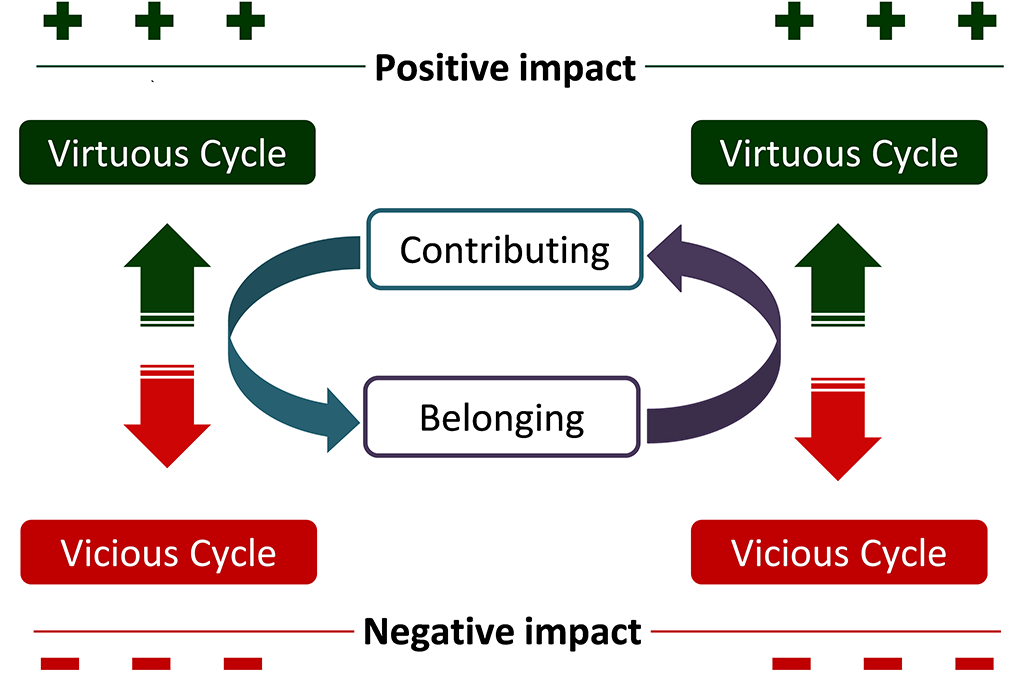Want to be more inclusive? Use contributing and belonging
Bright lights in dark days
It seems as if many organisations have made a big effort to be more inclusive during the COVID pandemic, but time will tell. So, let’s turn to a time when the world experienced similar turmoil: the 2008 GFC. Anon Ltd faced dire financial prospects early on. To survive, the medical equipment business needed to off-shore a substantial amount of production. Closure threatened the local factory. The response and subsequent outcomes were astounding.
Unlike many organisations at the time, senior management decided to seek extensive input from all its people. Individuals and groups were engaged in consultation and problem solving. Alternatives were examined, and reasons for choices discussed openly and frankly. Agreed changes included rostering shifts differently (which led to a reduction in pay), new production processes, training for all, and good treatment for those 350 people (out of 450) leaving.
Despite a massive 78% reduction in staff, the manner in which the downsizing was handled had a profoundly positive impact on people-relations. A pre- and post-climate survey found: managers being seen as good increased from 41% to 79%; rating of managers keeping their promise lifted to 72% from 32%; a sense of being treated fairly shifted from 50% to 76%; and 90% of people shared the values of the company, up from 70% before. Even though a massive number of colleagues lost their jobs, in the end 86% of staff felt proud to tell others they worked for the company, up from 78% previously.
Contributing and Belonging – the basis of inclusion
This remarkable account of survival, during exceptionally severe global economic conditions, demonstrates the impact of two interdependent factors at work. UGM research on inclusion has highlighted the role, and interplay, of contributing and belonging. The model we have developed provides a powerful way for people to think about inclusion and performance in the workplace. It is also useful for analysing aspects of relationships.


An often overlooked or under-appreciated fact, people join organisations (and groups) with a view to making a contribution. Being social, we are also seeking a sense of belonging through our membership. Importantly, the one feeds off the other, either positively or negatively. Those wanting to be inclusive leaders should keep this front of mind.
The contributing-belonging cycle
We make our contribution expecting to derive a sense of belonging. It’s the influential Law of Reciprocity in play. We know that what is experienced as belonging differs from person to person. Pay is an obvious candidate. But there are many others. For example, recognition, strong alignment of personal and group values, and autonomy, which lets us know we’re trusted to act responsibly.
When we experience belonging, we are motivated to contribute further, and probably also more. In a workplace, we expend discretionary effort. We willingly go the ‘extra mile’ when we’re included. We all know the difference that this makes to our output, or contribution. Research has confirmed productivity gains in excess of 200%, compared with those who don’t feel the sense of belonging.
As long as this climate is sustained, we can expect a positive loop where increased contributing leads to increased belonging. In addition to outstanding workplace climate results, from other research we can predict increases in productivity, enhanced customer satisfaction, fewer sick days and less accidents, and increased innovation. Inclusion pays!
The flip side is that we can get caught in a downward or vicious cycle. When we aren’t included and able to contribute, belonging is diminished. In turn, we reduce our contribution. Quickly, we dislike where we’re working, or who we’re working with. Our contribution plummets. At best there’s a work-to-rule. At worst, we may do as little as we can.
Brain science and Contributing-Belonging
Neuroscience findings highlight why we respond so strongly to contributing and belonging. When we’re connecting with others, levels of stress hormones (epinephrine, norepinephrine & cortisol) decrease. Dopamine, which raises attention levels and sense of pleasure, also increases. At the same time, we produce more serotonin, which reduces worry and fear. Finally, we produce more oxytocin and/or vasopressin which makes us more trusting of others.
All these powerful physical drivers determine our emotional state. Our emotional state, in turn, usually has a major impact on our behaviour. If people feel included, without even thinking about it, they’re likely behave in ways that will increase contribution.
Tapping into the virtuous cycle
What is your state? Examine your levels of contributing and belonging. Are you working in a virtuous or vicious cycle? What about those working for or around you? Tips in the side-bar will help ensure that you’re operating (and benefitting from) an inclusive, virtuous contributing-belonging cycle.
PRACTICAL IDEAS TO APPLY IN YOUR BUSINESS
Build inclusion through a virtuous contributing-belonging cycle
- To help people contribute, be sure to have clearly stated goals. Is your strategy shared, or is it a closely guarded secret?
- Thinking about strategy, to what degree are people able to contribute to its development? How might that impact on their sense of belonging and contributing?
- We all have our own sense of what we value. How recently have you taken the time to clarify what you currently value? Do you have an unexplained, lingering dissatisfaction? Chances are it’s because you’re not getting what’s needed to satisfy your personalised sense of belonging.
- Are you aware of what others around you value? If you aren’t, you’ll probably not be able to tap into the virtuous contributing-belonging cycle.
- Get others to help you generate a positive cycle. Have you told your colleagues what you value?
- Listening can be a very powerful way to show you really are concerned about others. Do you talk more than you listen?



